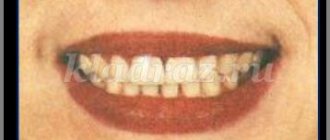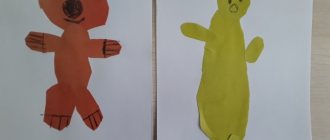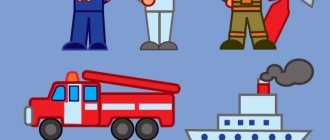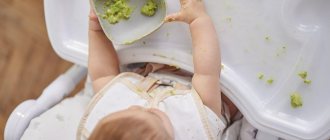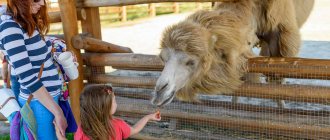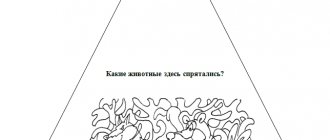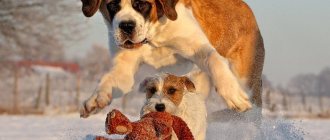Speech game on the topic “Toys” 4. “How we play”
We learn to select actions (verbs) to an object (noun).
Tanya and Vanya love to play with toys. And they want to know how you play with your toys. Let's tell them about our games (you can use a toy phone). You “dial a number” on a toy phone and start a conversation: “Hello, Tanya and Vanya! This is Danilka calling you. How are you? We are playing, do you want to know how? Now Danilka and I will tell you”:
Danilka (your child’s name), what are we doing with the ball? We roll, throw, catch (we choose words together with the baby). If a child wants to show how he does it, let him show all the actions right there. During the demonstration of actions, he can remember new actions and name them too, or he can come up with them.
- What does the ball do? Rolls, flies, bounces, bursts, jumps, jumps, hits the floor, etc.
- What do we do with the doll? We put the doll to bed, feed, drink, dress, undress the doll, rock it, and take it for a walk.
- What does the doll do? Walks, eats, sings songs, dresses, walks, dresses up, plays, dances.
- What do we do with the car? How do we play with it? We drive, load bricks into the back, honk the horn, catch up with other cars, stop, brake.
- What does the machine do? It drives, rushes, stops, accelerates, skids, drives into a garage, brakes, rolls over, breaks down, gets stuck, drives out, overtakes other cars.
For this game you can choose any toys that your child loves.
Speech game with toys 3. Bunnies
Let's get acquainted with toy bunnies: part 1.
We teach kids to describe pictures of toys, compare, analyze, use verbs exactly according to their meaning (distinguish between perfective and imperfective verbs), use diminutive suffixes (baby, bunny, hare, hare, eyes, ears, tail, etc. ).
To play, you will need a picture or three toy bunnies, which you will dress in different ways. These can be bears, dolls and any other toys instead of bunnies.
The first bunny is Shustrik. He is wearing a jacket and trousers. The second is Toropyzhka. He is wearing a jacket that is buttoned incorrectly - as a result, one bottom edge is higher than the other, sticks out unattractively, his hat is on his side, his scarf is tied sloppily on his side. The third one is Catch-up. He hasn't had time to get dressed yet, he's only wearing trousers.
Look at pictures or toys with your child and tell him a story about three bunnies.
“Vanya and Tanya live with three toy bunnies. The first bunny is always in a hurry, in a hurry and therefore does a lot of things wrong. That’s what the guys called him – Toropyzhka. Find it in the picture. How did you guess that it was Toropyzhka?
The second bunny does everything deftly, skillfully, quickly, correctly, smartly. Can you guess what his name was? What would you call an agile, nimble bunny? Interesting names you came up with! Do you want to know what Tanya and Vanya called him? They called him Shustrik because he was very... (smart).
The third bunny is always late, does not have time, and does things very slowly and leisurely. They often tell him: “Catch up with us.” That's why they named it - what do you think? Give him a name that makes it clear that he does everything slowly. What would you call such a bunny? (Encourage any option the child has - this is his word creation, and offer your own options). And Tanya and Vanya called him that - Catch-up.
Find Shustrik and Catch-up in the picture. How did you guess that this is Shustrik, and this is Catch-Up (the child explains).
Playing riddles: part 2.
These toy bunnies are brothers. They are very similar to each other. How are they similar? (They have long ears, short tails, round eyes, small noses, they are white, fluffy, they can jump, they love carrots, etc.).
How are bunnies different? (Look at clothes, shoes, eyes, noses, what the bunnies do).
How can you call a bunny affectionately? (Bunny, bunny, bunny, bunny).
What is the affectionate name for a bunny's ears? Yes, ears.
What is an affectionate name for your nose? (nose).
Eyes - ? (eyes)
Paws - ? (paws)
Tail? (tail)
Let's play riddles. I'll wish for a little bunny, and you guess his name.
You describe a bunny - a toy or a bunny from a picture, and the child must guess his name.
“This little bunny is very cheerful. He has big blue eyes. The bunny's nose is black and small. The bunny's ears are long and his tail is short. He is wearing a red jacket and blue trousers. The jacket has a blue collar and many round buttons. The little bunny loves to sing songs. Who is this?"
Now tell me a riddle: “My little bunny... He has.... The eyes of a bunny... The little bunny has a nose... Bunny loves...” (We help the baby construct a statement - a description, giving him support - the beginnings of phrases).
Who does what: part 3.
Every morning Tanya and Vanya play with the bunnies. Look at the toys (act out a scene). Toropyzhka and Shustrik have already gotten out of bed (we show), and Catch-up is still getting up. And it always happens. Listen and guess who is doing what (the child finishes the end of the phrase by analogy).
- Shustrik has already washed his face, and Catch-up is still... (washing himself).
- Shustrik has already gotten dressed, and Catch-Up is still...(getting dressed).
- Shustrik has already brushed his teeth, and Catch-Up is still...(cleaning).
- Shustrik has already had breakfast, and Catch-up is still...(having breakfast).
- Toropyzhka and Shustrik are already getting ready for a walk, and Catch-up is still...(getting ready).
Speech game with toys 2. “Teams”
We teach the child to use verbs in the imperative mood in speech. We prevent and correct grammatical errors in children's speech.
Tanya and Vanya's toys love to follow their commands. Let's teach your toys to perform different commands.
Ask your child to choose a favorite toy to teach. The toy (in the hands of an adult) carries out the baby’s command only if he has not made a grammatical error. In case of an error, the toy “wait” for the child to correct his mistake himself or with the help of adults.
First, you help the child give commands to the toy: “Ask the doll to dance, lie on its back, sing, etc.”, then the child comes up with the commands, and you only help him, suggest the correct option if necessary. In the future, you can change roles with the child.
Below I give a selection of words that children very often make mistakes and say, for example, like this: “lie down”, “wave”, “sing”, “wake up”. These mistakes will very quickly disappear from children’s speech after our fun game. The main thing is to repeat the game many times with different toys and different teams. Commands can be made by an adult, a father and mother, or a child at your request - come up with your own options! Have fun playing!
Sample commands for playing with a toy: sit down, bend over, wave your hand, sing, dance, draw, run, jump, sleep, wake up, clap your hands, stomp, lie on your back, lie on your tummy, comb your hair, ride, sit, jump over ..., touch your nose (ears, tail, mouth), etc.
Program content: continue to introduce children to objects made of wood, a variety of wooden toys. Give an idea (using the example of sharpening pencils) that soft wood is easy to cut with a sharp knife. To cultivate a caring attitude towards the toy, an interest in its manufacture, and in the masters - woodcarvers.Material: book by A. Tolstoy “The Golden Key, or the Adventures of Pinocchio”; pencils that require sharpening; samples of Bogorodsk carved toys: pecking chickens, etc.; nesting dolls, pyramids; a Pinocchio doll with a bag or basket containing any wooden figures and objects (spoons, cutting boards, etc.); safe pencil sharpeners.
Children are seated around tables of 4-6 people.
Progress of the lesson
Part 1. Buratino comes to the group. The teacher introduces the children to the doll. Reports that the hero of the fairy tale “The Golden Key, or the Adventures of Pinocchio” is a wooden boy who was carved from a log by dad Carlo. Shows the book (2-3 illustrations) and says that he will tell about the adventures of this boy later, and now the most important thing is that Pinocchio knows everything about wooden objects - how they are cut, sharpened, painted, because he himself was cut out of wood with a knife .
Pinocchio reports that he has many different wooden objects in his bag. Wants to show them off. The teacher says that first he will show everyone how to cut wood with a knife. He sits the doll down and sharpens a pencil, explaining that pencils are made from soft wood so they can be easily sharpened when they break. Then he distributes 1-2 sharpeners and several pencils to each table. Invites children to try sharpening pencils themselves. Draws children's attention to the shavings and the fact that they can be easily removed from the pencil.
Next, Pinocchio takes out wooden objects, the teacher shows them and explains how to cut out spoons, boards, and cups. Gives objects to children, asks them to stroke them, trace their outline with a finger, feel the warmth and smell of the wood. After inspection, he puts all the items on the shelf and thanks Pinocchio for bringing them. He says that children already know something about wooden objects.
Part 2. Everyone walks around the group together. Children show the doll wooden furniture and what they repaired last time.
3rd part. The teacher asks everyone to sit down and says that he wants to show everyone the wonderful wooden toys that are made by master woodcarvers from various villages and cities in Russia. One of these places is the village of Bogorodskoye in the Moscow region, where famous wooden toys are made. They are very funny because they can move. Reads the poem by O. Krieger “That’s how chickens are!”
Just pull the string
Chickens peck the grains,
The teacher demonstrates pecking chickens, then other Bogorodsk toys. Shows nesting dolls and pyramids. Distributes all the toys to the children and invites them to take turns playing with them. He himself, together with Pinocchio, helps children properly swing chickens and play with other toys. Asks the children to carefully examine the toys: how the figures are cut, how they are connected, why they move.
The cockerel will perk up.
There's a knock and a knock on the board. Along with the chickens, knock-knock.
Never get tired.
Chickens peck the grains, but do not lay eggs.
These are how strange Wooden Chickens are!
At the end of the lesson, the teacher reminds that all these toys are made of wood by craftsmen, they must be handled with care and not broken.
Wooden objects and toys remain in the group until the end of the day, the teacher allows them to be used.
Speech game with toys 1. “Guess which toys are gone”
We teach the child to use words - the names of toys in the genitive plural.
Meet me! This is brother and sister. Their names are Tanya and Vanya.
Tanya and Vanya have a lot of toys. Look at the picture and name Tanya’s toys (dolls, nesting dolls, jump ropes, bears, ducklings, pyramids).
Let's play with Tanya's toys. I will hide the toys, and you can guess what is missing (cover one picture with your palm or finger and ask: “What is missing?”). The child tries to guess and answers: “There are no more dolls.” If you use a set of pictures, then simply remove one picture, and the child can guess what is missing.
Be sure to praise your child and rejoice with him at the correct answer. If your child made a grammatical mistake (for example, he said: “there are no more jumping ropes or ducklings”), do not repeat the mistake after him. Instead, immediately say the correct option: “You guessed right. Well done! There are no jump ropes."
Now look at Vanya’s toys. What toys does Vanya have? (Cubes, drums, planes, cars, balls, shovels, horses). Let's play with them (“there are no more cars, balls, etc.”).
pictures of toys that can be used for this game in the article “Pictures: Children's Toys”, which will be published tomorrow. All the pictures are of good quality, they can be printed on a printer or included in a presentation, made into a game of paired pictures, or viewed with children and asked riddles.
You can also use real toys for the game (two bears, two cubes, etc.)
